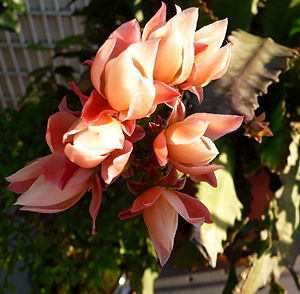- Disocactus phyllanthoides
-
Disocactus phyllanthoides Disocactus phyllanthoides
Systematik Ordnung: Nelkenartige (Caryophyllales) Familie: Kakteengewächse (Cactaceae) Unterfamilie: Cactoideae Tribus: Hylocereeae Gattung: Disocactus Art: Disocactus phyllanthoides Wissenschaftlicher Name Disocactus phyllanthoides (DC.) Barthlott Disocactus phyllanthoides ist eine Pflanzenart aus der Gattung Disocactus in der Familie der Kakteengewächse (Cactaceae). Das Artepitheton phyllanthoides bedeutet ‚(lat.) ähnlich phyllanthus‘.
Inhaltsverzeichnis
Beschreibung
Disocactus phyllanthoides wächst reich verzweigt und wird dabei bis zu 1 Meter lang. Die Haupttriebe sind basal stielartig geformt, im oberen Teil abgeflacht. Die Seitentriebe sind hellgrün, oft auch rot überhaucht. Sie haben vorstehende Mittelrippen und Seitennerven und sind dabei lanzettlich, drehrund, abgeflacht und zugespitzt stumpf gezähnt. Sie werden 15 bis 30 Zentimeter lang und 2,5 bis 4 Zentimeter breit. Die Areolen sind unbedornt. Die glockigen bis trichterförmigen rosafarbenen Blüten erreichen eine Größe von 8 bis 10 Zentimeter Länge und 7 bis 9 Zentimeter im Durchmesser. Die 3 bis 4 Zentimeter im Durchmesser großen und etwas gerippten Früchte sind anfangs grün und später rot gefärbt.
Verbreitung und Systematik
Disocactus phyllanthoides ist in den mexikanischen Bundesstaaten Puebla und Veracruz verbreitet und kommt in Höhenlagen zwischen 1500 bis 1850 m vor.
Die Erstbeschreibung als Cactus phyllanthoides erfolgte 1813 durch Augustin-Pyrame de Candolle.[1] Wilhelm Barthlott stellte die Art 1991 zu Disocactus.[2]
Synonyme sind folgende beschriebenen Arten und Varietäten: Cactus phyllanthoides DC. (1813), Epiphyllum phyllanthoides (DC.) Sweet (1826), Cereus phyllanthoides (DC.) DC. (1828), Phyllocactus phyllanthoides (DC.) Link (1831), Nopalxochia phyllanthoides (DC.) Britton & Rose (1923), Heliocereus phyllanthoides (DC.) Doweld (2002) und Epiphyllum speciosum Haworth (1819).
Nachweise
Literatur
- Edward F. Anderson: Das große Kakteen-Lexikon. 2. Auflage. Eugen Ulmer KG, Stuttgart 2011 (übersetzt von Urs Eggli), ISBN 978-3-8001-5964-2, S. 186.
- Ulises Guzmán, Salvador Arias, Patricia Dávila: Catálogo de cactáceas mexicanas. Universidad Nacional Autónoma de México, Mexiko-Stadt 2003, ISBN 970-9000-20-9, S. 58.
Einzelnachweise
- ↑ Catalogus Plantarum Horti Botanici Monspeliensis. 84, no 41 (1813) (online)
- ↑ Bradleya. Band 9, 1991, S. 88.
Weblinks
Wikimedia Foundation.


